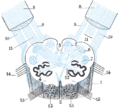| Arcuate nucleus (medulla) | |
|---|---|
 Transverse section of medulla oblongata below the middle of the olive. ("Nucleus arcuatus" visible near bottom right.) | |
 Dissection of brain-stem. Lateral view. (Labels for "External arcuate fibers" and "Dorsal external arcuate fibers" visible at lower right.) | |
| Details | |
| Identifiers | |
| Latin | nucleus arcuatus medullae oblongatae |
| NeuroNames | 775 |
| NeuroLex ID | birnlex_2635 |
| TA98 | A14.1.04.256 |
| TA2 | 6016 |
| FMA | 72609 |
| Anatomical terms of neuroanatomy | |
In the medulla oblongata, the arcuate nucleus is a group of neurons located on the anterior surface of the medullary pyramids. These nuclei are the extension of the pontine nuclei. [1]
Contents
They receive afferents from the corticospinal tract.[ citation needed ]
They in turn project efferents into the cerebellum through the inferior cerebellar peduncle as: [1]
- the anterior internal arcuate fibers which pass along the midline before decussating near the rhomboid fossa (floor of fourth ventricle) then passing laterally as the medullary striae;
- the anterior external arcuate fibers.

